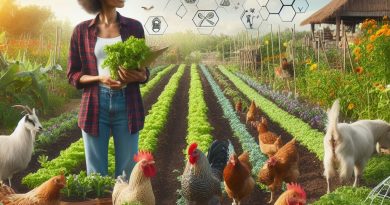Tech in Agriculture: Regulatory Landscape
Last Updated on March 2, 2024
Introduction
In today’s modern world, technology plays a crucial role in the agricultural sector.
Farmers and agricultural companies are increasingly adopting innovative technologies to enhance productivity and efficiency.
This growing trend of technology adoption in agriculture is revolutionizing the industry.
Technology in agriculture is vital as it offers numerous benefits to farmers.
With the help of advanced machinery, farmers can increase their yield and reduce labor costs.
Agricultural technology also enables farmers to monitor and control the growth of crops, ensuring optimal conditions for their development.
Furthermore, technology facilitates precision farming, allowing farmers to use resources efficiently and minimize waste.
The agricultural sector is experiencing a significant shift towards technology adoption.
Farmers are increasingly embracing smart farming techniques, which involve the use of sensors, remote monitoring, and automation.
These technologies enable farmers to collect real-time data about soil conditions, weather patterns, and crop health, thus making informed decisions to maximize yields.
Moreover, the use of drones for crop surveillance and precision agriculture has gained popularity, providing valuable insights and reducing the need for manual labor.
In fact, technology has become indispensable in agriculture, revolutionizing the way farmers cultivate their crops.
The growing trend of technology adoption in the agricultural sector is transforming traditional farming practices and leading to increased productivity and sustainability.
As technology continues to advance, it is crucial for regulators to adapt and create policies that ensure its safe and responsible use in agriculture.
Read: Organic Farming Regs: What’s New in 2024?
The Regulatory Landscape in Agriculture
Overview of the regulatory environment
- Agriculture is a highly regulated industry, with various laws and policies governing its operations.
- These regulations aim to ensure food safety, protect the environment, and promote sustainable farming practices.
- Government agencies play a crucial role in formulating and enforcing these regulations.
- Compliance with regulatory requirements is essential for farmers and agribusinesses to stay in operation and avoid penalties.
Influence of regulations on technology adoption
- The regulatory landscape significantly impacts the adoption and diffusion of technology in agriculture.
- Regulations can either encourage or deter the use of innovative technologies in farming.
- For example, regulations that promote organic farming practices may boost the adoption of organic technology solutions.
- Conversely, regulations restricting the use of certain pesticides or genetically modified organisms may hinder technology adoption in those areas.
Role of government agencies in formulating regulations
- Government agencies at the national, state, and local levels have distinct roles in formulating agricultural regulations.
- These agencies include the Environmental Protection Agency, Department of Agriculture, and Food and Drug Administration.
- They collaborate with industry experts, scientists, and stakeholders to develop evidence-based regulations.
- Government agencies also conduct inspections, monitor compliance, and impose penalties for non-compliance with regulations.
Importance of effective regulation in agriculture
- Effective regulations ensure the safety of agricultural products for consumers and the environment.
- They help prevent the outbreak of diseases, contamination of crops, and the misuse of agricultural chemicals.
- Regulations also promote fair competition, prevent monopolies, and protect the rights of farmers.
- Furthermore, well-crafted regulations can encourage sustainable farming practices and innovation in the industry.
Challenges in the regulatory landscape
- The regulatory landscape in agriculture faces challenges in keeping up with the rapid pace of technological advancements.
- It can be challenging to strike a balance between fostering innovation and ensuring safety and environmental protection.
- Lack of harmonization between national and international regulations can create barriers to trade and limit market access.
- Additionally, complying with regulations can impose financial burdens on small-scale farmers and hinder their competitiveness.
The future of agricultural regulations
- As technology continues to advance, agricultural regulations will need to evolve accordingly.
- Regulators will need to adapt and develop frameworks that allow for innovation while maintaining safety and sustainability.
- Collaboration among government agencies, industry stakeholders, and technology developers will be crucial in shaping future regulations.
- Embracing emerging technologies such as precision agriculture and blockchain can enhance transparency and accountability in the regulatory landscape.
- The regulatory landscape in agriculture plays a vital role in ensuring food safety, environmental protection, and innovation.
- Government agencies have the responsibility to develop and enforce regulations that strike a balance between safety and technological advancement.
- Overcoming the challenges and embracing emerging technologies will shape the future of agricultural regulations.
Ultimately, a well-regulated agricultural industry benefits not only farmers but also consumers, the environment, and the overall economy.
Read: Climate Change Policy: Effects on Farming
Explore Further: Water Rights & Taxes: What to Know
Key Regulations Impacting Agricultural Technology
In the realm of agricultural technology, several key regulations have a significant impact on the industry’s development and adoption.
This section will explore four important areas of regulation and their implications for agricultural technology.
Genetically Modified Organisms (GMOs)
Regulations regarding GMO cultivation and labeling play a crucial role in ensuring transparency and consumer choice.
Governments around the world enforce strict guidelines to regulate the production and distribution of genetically modified crops.
These regulations cover various aspects, including environmental risk assessments, field trials, and labeling requirements.
Controversies surrounding GMOs and their impact on technology adoption continue to shape the regulatory landscape.
Concerns about the potential risks and long-term effects of genetically modified organisms contribute to the ongoing debate.
Despite these controversies, GMOs have the potential to revolutionize agriculture and address food security challenges.
Pesticides and Herbicides
Regulations on pesticide and herbicide usage in agriculture aim to protect human health and the environment.
Governments set limits on pesticide residues in crops and establish guidelines for their application.
These regulations ensure that agricultural chemicals are used responsibly and in compliance with safety regulations.
Safety and environmental concerns drive the need for stricter regulations and alternative approaches to pest and weed control.
The potential impact of pesticides and herbicides on non-target organisms, water quality, and soil health calls for sustainable farming practices and the development of eco-friendly alternatives.
Water and Soil Management
Regulations promoting sustainable water and soil management practices are essential for safeguarding natural resources for future generations.
Governments encourage farmers to adopt practices that preserve water quality, conserve water resources, and support soil health.
These regulations promote the adoption of precision irrigation technologies, water recycling systems, and techniques like soil erosion control measures.
The integration of technology in water and soil management practices is crucial for achieving optimum resource utilization.
Advanced monitoring systems, data-driven decision-making tools, and precision agriculture techniques enable farmers to make informed choices, improve efficiency, and reduce environmental impact.
Data Privacy and Security
Regulations ensuring data privacy and security in agricultural technology are vital to protect sensitive information.
Given the increasing reliance on data-driven decision-making in agriculture, governments introduce laws to prevent unauthorized access, data breaches, and misuse of agricultural data.
These regulations establish guidelines for data collection, storage, and sharing practices, ensuring stakeholders’ trust.
Challenges arise in managing and protecting agricultural data due to its volume, complexity, and diverse sources.
Implementing robust data protection measures can be challenging while maintaining data accessibility for authorized users.
Striking the right balance between data security and usability remains a continuous challenge for agricultural organizations.
In a nutshell, key regulations significantly impact agricultural technology.
Regulations addressing GMOs, pesticides, water and soil management, and data privacy and security play a pivotal role in shaping the path of technological advancements in agriculture.
Striking the right balance between innovation, sustainability, and consumer safety is essential for the future of agriculture.
Read: US-China Trade: Effects on Agriculture Sector

The Future of Agricultural Technology Regulations
In the fast-paced world of agriculture, technology continues to advance at a rapid pace, providing farmers and producers with innovative solutions to boost productivity and efficiency.
However, these advancements come with their own set of regulatory challenges that need to be addressed.
Emerging technologies and their regulatory challenges
As technology continues to evolve, emerging innovations such as drones, autonomous vehicles, and genetic engineered crops bring new regulatory challenges.
Regulators are faced with the task of evaluating the safety, ethical, and environmental impacts of these technologies.
Ensuring the responsible use and adoption of emerging technologies becomes crucial while minimizing potential risks.
Striking a balance between fostering innovation and protecting public health and the environment is of utmost importance.
Shifts towards more flexible regulations to encourage innovation
Recognizing the need for innovation in agriculture, regulatory agencies are increasingly embracing more flexible regulations.
Traditional regulatory frameworks often struggle to keep up with the pace of technological advancements.
By adopting flexible regulations, regulators can encourage and facilitate the introduction of new technologies into the agriculture sector.
This shift allows for a more adaptive and responsive approach to regulating the rapidly changing agricultural technology landscape.
Agile regulation frameworks can also foster collaboration between regulators, researchers, and technology developers to ensure effective oversight.
Global harmonization of agricultural technology regulations
With the increasing globalization of agricultural markets, there is a growing need for harmonized regulatory standards across countries.
Differences in regulatory requirements can create barriers to trade and hinder the global adoption of agricultural technologies.
A global harmonization of agricultural technology regulations can facilitate knowledge sharing and best practices among countries.
Efforts to establish international regulatory frameworks have gained traction, enabling smoother market access for innovative agricultural technologies.
This harmonization enables stakeholders to navigate the complex global regulatory landscape more efficiently.
In summary, the future of agricultural technology regulations lies in addressing the challenges posed by emerging technologies, embracing flexible regulations to encourage innovation, and promoting global harmonization of standards.
By acknowledging the need for regulatory frameworks that are adaptable and responsive to technological advancements, regulators can ensure the responsible and sustainable adoption of agricultural technologies.
Furthermore, global harmonization of agricultural technology regulations enables collaboration and knowledge-sharing, fostering a more efficient and effective regulatory landscape.
Read: EU New Agri-Subsidies: A Deep Dive Analysis
Conclusion
The regulatory landscape in agriculture plays a crucial role in ensuring the safe and responsible deployment of technology.
This article has highlighted the various regulations that govern the use of technology in agriculture.
We have discussed the importance of striking a balance between regulations and technological advancements.
While regulations are necessary to protect the environment, human health, and consumer interests, they should not stifle innovation and hinder the adoption of beneficial technological solutions.
Looking ahead, there are potential future developments in agricultural technology regulations.
As technology continues to advance rapidly, regulators need to keep pace and update their frameworks to address emerging challenges and opportunities.
It is crucial for regulators to collaborate with industry stakeholders, researchers, and policymakers to foster a supportive regulatory environment that encourages innovation while ensuring that technology is used responsibly and sustainably.
A well-thought-out and balanced regulatory landscape is essential for fostering the growth and development of agricultural technology, ultimately benefitting farmers, consumers, and the environment.


